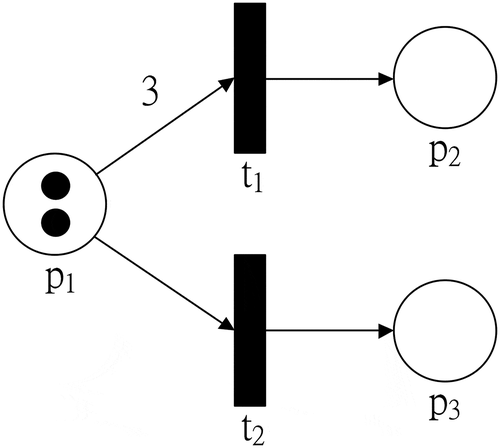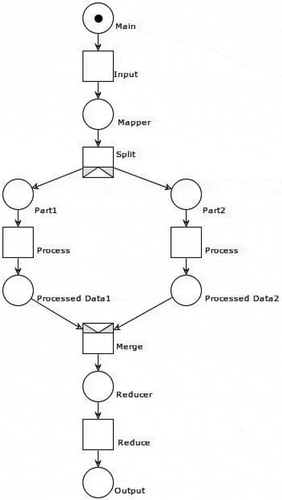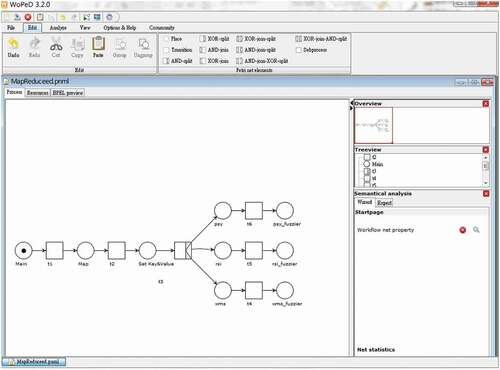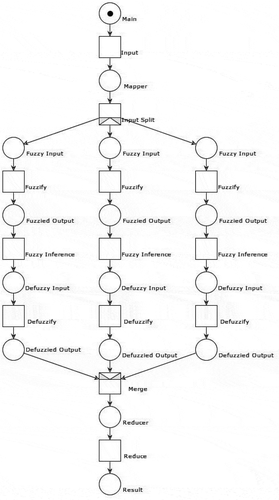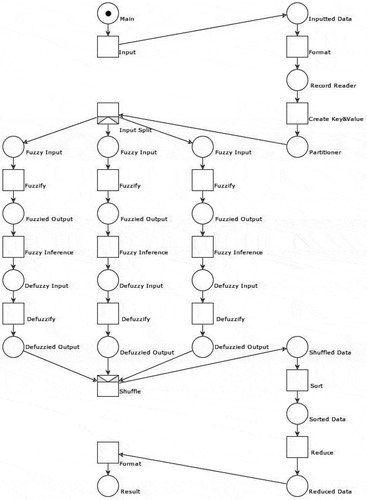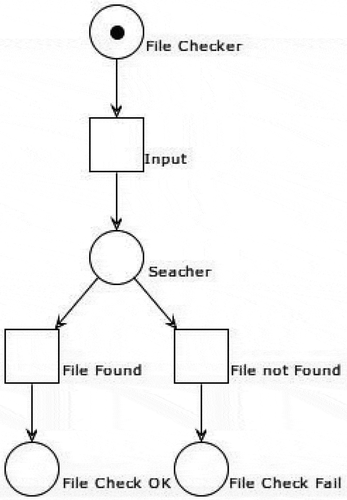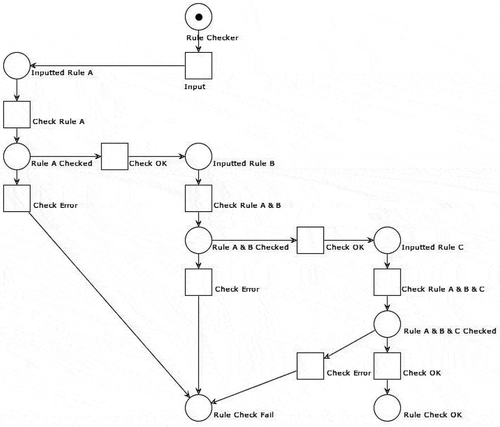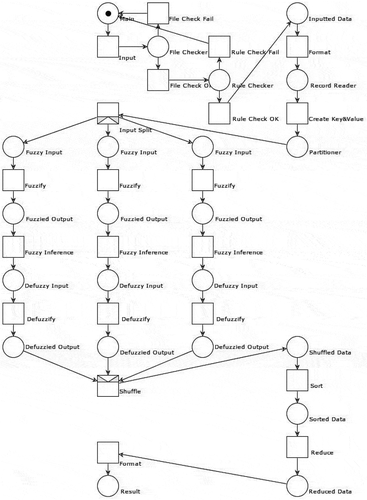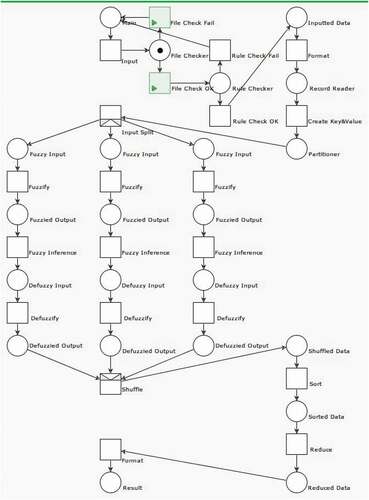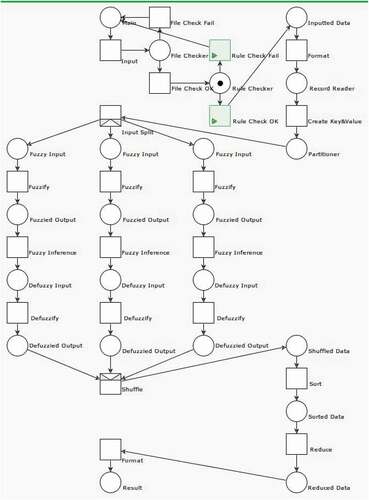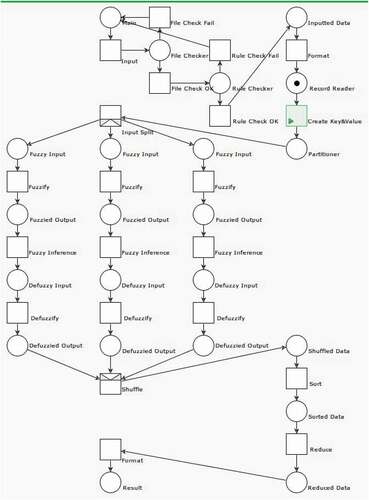 ?Mathematical formulae have been encoded as MathML and are displayed in this HTML version using MathJax in order to improve their display. Uncheck the box to turn MathJax off. This feature requires Javascript. Click on a formula to zoom.
?Mathematical formulae have been encoded as MathML and are displayed in this HTML version using MathJax in order to improve their display. Uncheck the box to turn MathJax off. This feature requires Javascript. Click on a formula to zoom.ABSTRACT
Information technological advances have significantly increased large volumes of corporate datasets, which have also created a wide range of business opportunities related to big data and cloud computing. Hadoop is a popular programming framework used for the setup of a cloud computing system. The MapReduce framework forms a core of the Hadoop program for parallel computing and its parallel framework can greatly increase the efficiency of big data analysis. This paper aims to adopt a Petri net (PN) to create a visual model of the MapReduce framework and to analyze its reachability property. We present a real big data analysis system to demonstrate the feasibility of the PN model, to describe the internal procedure of the MapReduce framework in detail, to list common errors and to propose an error prevention mechanism using the PN models in order to increase its efficiency in the system development.
Introduction
Modern advances in computer technology and Internet system have led an increasing number of corporations and small businesses to setting up webpages and posting their information on computers. This has resulted in an enormous volume of datasets that continue to grow, which in turn spurred the development of concepts such as cloud computing and big data. At present, the research is focused on the development of business opportunities related to the analysis of big data. This kind of resource-heavy research has been made possible by the contributions of cloud computing made by corporations such as Google, Yahoo, and Apache (Jadhav, Pramod, and Ramanathan Citation2019; Valero Citation2018; White Citation2009).
Hadoop is a popular programming framework used for the setup of cloud computing systems. The MapReduce framework forms the core of the Hadoop program for parallel computing. The Map function sorts datasets into <key, value> pairs that are then distributed to various nodes for parallel computing. The Reduce function collects the sorted datasets and yields the results. Because Hadoop is an open-source program, the system developer can rewrite a generation method of the <key, value> pairs, for sorting and sequencing of the data sets, and collecting and sequencing of the MapReduce framework. This requires that the system developer should have a comprehensive understanding of the MapReduce framework. In the absence of customization by the system developer, Hadoop uses its default settings. However, this can produce the results that were not anticipated by the system developer. This case underlines the importance of developing guidelines to help the developer construct the systems they envisage.
Despite its widespread applications, few researchers have verified whether the MapReduce framework is reachable or not. Rather, the majority of research work into MapReduce has focused on its space utilization and time efficiency. Computation tree logic (CTL) (Camilli et al. Citation2014) and linear temporal logic (LTL) (Hallé and Soucy-Boivin Citation2015), for example, are two analysis approaches that use mathematical models to track the conditional transitions for system verification.
This study employs a Petri net model to verify the reachability of the MapReduce framework and to assist the system developer in developing parallel MapReduce systems. Petri net theory was developed by Dr. Carl Adam Petri at the University of Bonn in Germany in 1962. A Petri net is a mathematical and graphical tool which is widely used in modeling and simulating system behaviors under various circumstances. It comprises places, transitions, arcs, and tokens; and offers a module of expressing a system which is concurrent, asynchronous, distributed, parallel, nondeterministic, or stochastic (Mazhar Rathore et al. Citation2018). In the system simulation, a high correlation has been demonstrated to exist between liveness and deadlocks, which can be tested and analyzed using the attributes of Petri nets. Petri nets provide a visually interactive tool (Wu and Zhou Citation2010) and have been widely applied in a number of fields.
The use of Petri nets benefits the modeling and analysis of the MapReduce framework because Petri nets are well suited to the description of parallel computer models. They can also be represented by stringent mathematical expressions as well as intuitive graphical expressions. The complete representation of the MapReduce framework, the system development examples, and the common errors made by this study will hopefully be of great help to the system developer in the development of parallel MapReduce systems.
The remainder of this study is organized as follows. The origin of the MapReduce framework in Hadoop, the structure of the Petri net model and its attributes are explained in Section 2. In Section 3, the Petri net model is presented to explain how the MapReduce framework can assist us in the system development. In Section 4, the common errors that arise in the development of parallel MapReduce systems and the means of preventing them are listed. The proposed approach is also compared with other common analysis methods. Section 5 outlines the contributions of this study and provides the system developer with a standard model with a low error rate.
Literature Review
In this section, we present a detailed introduction of Hadoop and the basic components with properties of a Petri net. Then, simple MapReduce programs are used to conduct reachability tests, and CLT as well as LTL, two common analysis methods, are presented. Finally, WoPeD (Workflow Petri Net Designer), the Petri net software tool, is introduced.
Framework of Hadoop MapReduce
Apache Hadoop is an open-source programming framework for distributed data-intensive applications implemented using Google’s MapReduce framework and Google File System. It can decompose distributed data sets and applications into multiple smaller tasks and then delegates them to various nodes for parallel processing (White Citation2009).
Hadoop uses the Hadoop Distributed File System (HDFS) to store data sets. The purpose of the HDFS is to develop a distributed file system that can be constructed using commercially available hardware. The HDFS features scalability, cost efficiency, flexibility, and fault tolerance.
MapReduce is a distributed processing library that enables applications to be written for easy adaptation to parallel execution by decomposing the entire job into a set of independent tasks. An application written using the MapReduce library is organized as a set of independent tasks which can be executed in parallel (Neil, Gunther, and Tomasette Citation2014).
The framework of MapReduce has been implemented using the one published by Google. In the Map phase, Hadoop converts the input data into <key, value> pairs that are easy to manage. In the Reduce phase, its function is to collect all the <key, value> pairs for a specific key and transform them into a new <key, value> pairs, where the value of a key is the specific one. Their value is in a list [value1, value2, etc.] of all the values that are <key1, [value1, value2, etc.]> pairs whose key is the specific one across the entire input data sets (Neil, Gunther, and Tomasette Citation2014). By managing the Map and Reduce frameworks, the system developer can control all of the distributed processing procedure in a system (Valero Citation2018). A flowchart of MapReduce is depicted in .
Figure 1. Flowchart of MapReduce (White Citation2009)
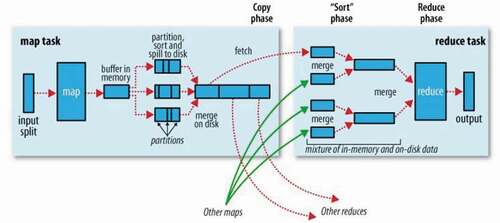
The key points that have earned the MapReduce framework of Hadoop praise and success include the following items:
It is easy to grasp, even for software engineers without experience in distributed systems.
Since Hadoop is an open-source framework, the system developer can customize its contents, such as <key, value> pairs generation method, as well as data distribution, thereby gaining greater control over their designs as well as greater flexibility.
MapReduce can process a wide variety of problems, such as Google searches and data mining.
The Hadoop system is highly scalable; i.e., it can comprise thousands of computers.
Petri Nets
An ordinary Petri net is described by using a four-variable network (Mazhar Rathore et al. Citation2018; Wu and Zhou Citation2010): PN = (P, T, A, M0), where P denotes a set of places, T denotes a set of transitions, A denotes a set of arcs, and M0 denotes an initial marking. The places in a Petri net comprise a finite set:
Generally, places are depicted with circles to signify the status of an object in the system. The presence of a token on a place means that this condition exists in the system. The transitions comprise a finite set:
Transitions are depicted with bars and indicate that the event described changes the state of the system. At the same time, these transitions also indicate the start and the termination of the system procedure. A transition fires if it meets the conditions such as weight, whereupon a token transits from its input Place i to its output Place j, which implies that the state of the system has been changed (Natesan et al. Citation2017; Xiong, Fan, and Zhou Citation2010).
An arc describes the correlations between places and transitions. It runs in a single direction and shows the direction of the token’s transition. A weight function w(pi,tj) can be added to an arc to show the weight it needs to transit from Place i to Place j. Initial Marking M0 denotes a set of tokens in the system. When a set of tokens changes, it indicates that the transition is fired. It means that the happening or action of an event, i.e. the dynamic behavior, is described in the Petri net.
A fundamental Petri net is used to describe the state change of a discrete event dynamic system, where a complete Petri net model includes places, transitions, arcs; and the flow of tokens are denoted as the state change of a dynamic system (Matsuzaki Citation2017; Saisai et al. Citation2016; Zhang, Zhang, and Ya Citation2010; Birzhandi et al. Citation2019). The basic Petri net model is depicted in .
In , there are three places, two transitions, four arcs including two input arcs and two output arcs, two tokens, and one Petri net marking. This basic model is denoted as
The transition of tokens in Petri nets is capable of modeling complex behaviors including various restrictions and parameters. As a result, Petri nets are widely applied in various fields.
Properties of Petri Nets
The properties of standard Petri net models can be divided into behavioral and structural properties (Mazhar Rathore et al. Citation2018). The former refer to the initial marking functions of Petri nets, whereas the latter describe the structures of Petri nets. Furthermore, our Petri net model can be described by using the following property.
Reachability
If the firing begins from M0, all reachable places will be derived after a series of firing transitions. Thus, the Petri net will be viewed as reachability. This property is mainly used to determine whether the operations of a work procedure are feasible or not.
Verification equation: Mi = AT‧X+ M0
In the above equation, A is the incidence matrix of a Petri net, M0 is the initial marking of the model, and the Mi marking is the verification goal, where i denotes any marking of the Petri net. Using this equation, we can obtain the transition vector X that enables the marking to be reachable from M0. If all of the markings in the Petri net can be reachable from M0, then the Petri net has reachability.
Incidence Matrix
In terms of analysis, a Petri net is a mathematical and graphical tool that has a greater mathematical ability to describe algebraic equations using matrices. A Petri net can be replaced with an incidence matrix A, which is defined as output flow matrix A+ minus input flow matrix A−. The former one is an n × m matrix with n and m denoting the numbers of places and transitions, respectively. Each incidence matrix indicates the relationship between a place and a transition, defined as
Input Flow Matrix: A−=[aij−], aij−=I(pi,tj)
Output Flow Matrix: A+=[aij+], aij+=O(ti,Pj)
and aij+ = w(i,j), aij− = w(j,i).
The incidence matrix is A=A+-A−,
where aij+ is the weight of the arc from transition i to place j; while aij− is the weight of the arc from place i to transition j. If the place and the transition have no correlation, both aij+ and aij− are 0s.
Petri Net Model of MapReduce Framework
We convert the MapReduce framework into a Petri net model according to (Wu and Zhou Citation2010). This MapReduce model is a basic example describing the operations of the MapReduce framework. Below is the algorithm, and the Petri net model is depicted in . We assume that this model has two nodes for the sub-jobs after a split.
Reachability Analysis Using Petri Net Model
We convert the visual Petri net model in into a mathematical matrix form and use the mathematical model for reachability verification. P0 ~ P7 and t0 ~ t5 denote the places and transitions, respectively.
Notations: P0 denotes Main, P1 denotes Mapper, P2 denotes Part 1, P3 denotes Part 2, P4 denotes Processed Data 1, P5 denotes Processed Data 2, P6 denotes Reducer, and P7 denotes Output. t0 denotes Input, t1 denotes Split, t2 denotes Process, t3 denotes Process, t4 denotes Merge, and t5 denotes Reduce.
Firing Sequence: t0, t1, t2, t3, t4, t5
M0 = [1 0 0 0 0 0 0 0]
t0![]()
M1 = [0 1 0 0 0 0 0 0]
t1![]()
M2 = [0 0 1 1 0 0 0 0]
t2![]()
M3 = [0 0 0 1 1 0 0 0]
t3![]()
M4 = [0 0 0 0 1 1 0 0]
t4![]()
M5 = [0 0 0 0 0 0 1 0]
t5![]()
M6 = [0 0 0 0 0 0 0 1]
This presents the state changes in the Petri net model after various transitions are fired. In the next step, we start to verify the reachability of the Petri net.
From the above equation, we get t0 = 1, t1 = 1, t2 = 1, t3 = 1, t4 = 1, t5 = 1. M6 = AT‧X+ M0, such that marking M6 can be reachable from marking M0.
Software Tool – WoPeD
WoPeD (Freytag and Sänger Citation2014) is an open-source software system developed at Cooperative State University Karlsruhe under the GNU Lesser General Public License (LGPL) for the creation and analysis of Petri net models. The goal of WoPeD is to create a user interface that is easy to use for analysis, modeling, and simulation. The developed interface is depicted in . WoPeD is the ideal Petri net analysis software for research personnel, professors, and students due to its user-friendly operation interface and easy-to-use procedure for checking the model vulnerabilities. It is widely applied all over the world and has been successfully used in numerous lectures and student projects.
The functions of WoPeD include the following:
Process and Resource Editor
PNML Compliance and Import/Export Formats
Soundness Checker
Interactive Simulator and Coverability Graph Visualization
Quantitative Simulation and Capacity Planning
Quantitative Simulation and Capacity Planning
Research Support Tool
AProMoRe Repository Front-End
The Proposed Approach
This study is affiliated with the research project sponsored by the Ministry of Science and Technology (MOST), Taiwan; and entitled Cloud-Based Learning and Analysis System for Big-Data. Below, we apply the Petri nets to model and analyze this project.
The purpose of the project is to enable users to customarily analyze the selected datasets. This includes rewriting the methods of <key, value> pairs generation and data distribution as well as adding check mechanisms to ensure that the results can be the same as anticipated. The system operating procedure is listed as follows: input file; check file; check rules; conduct mapping; perform the fuzzification, fuzzy inference, defuzzification, and reduction of the integrated data in the various nodes; produce results; and output results. We further explain the system development processes to illustrate the benefits of the proposed models.
Parallel MapReduce System for Big-Data Analysis
We conduct more thorough system development using the basic MapReduce framework in . During the analysis, the data sets must be fuzzified before the analysis calculations are performed by using fuzzy inference. The defuzzified data sets are then sent to the Reduce function for integration, which then yields the final results. Below is the algorithm, and the Petri net model is depicted in .
Detailed Procedure for Parallel MapReduce Framework
This system requires the customized methods for <key, value> pairs generation and data distribution, thereby necessitating a thorough analysis of the MapReduce framework. The algorithm presented below is converted into the Petri net model for the MOST-project as depicted in .
As can be seen, the Map framework includes an input format function to normalize the input data, a record reader to set the <key, value> pairs generation method, and a partitioner to determine the means of data distribution.
The Reduce framework contains the following steps: a shuffle function to compile the data, a sorting function to arrange the compiled data in alphabetic order, a reduce function for integration and simplification, and an output format function to normalize the data sets and to yield the final results.
Inclusion of Check Procedure in the System
To prevent the system errors and to ensure that users have not input interdependent or contradictory rules’ analysis, which will lead to errors in <key, value> pairs generation method, we add a file checker and a rule checker to the system.
File Checker
The purpose of the file checker is to ascertain whether the system contains the data uploaded by the user or not. During this execution, it ensures the following two cases:
Users have uploaded the data sets.
An output folder does not exist before the execution of the program. If it exists, the HDFS will not know where to put the results, and the Hadoop system will not run the program.
Below is the file-checker algorithm, and the Petri net model is depicted in .
Rule Checker
The rule checker examines each of the rules input by users for interdependence or contradiction. For example, consider two rules below:
If a is b then c is a.
If a is b then c is not a.
These rules are conflicting and will lead to abnormalities in the system analysis and therefore to the unanticipated results. They might also cause unnecessary operations that will waste system resources and increase execution time.
If the rules are independent but placed in the wrong order, errors will arise in the results. For example, consider three rules below:
If c is d then e is f.
If e is f then g is h.
If a is b then c is d.
Users intend to obtain the following rule: “if e is f then g is h.” However, problems in the order of execution may lead to problems in the analysis or the results. Below is the rule-checker algorithm, and the Petri net model is depicted in .
Big Data Analysis System by Inclusion of Checking Mechanism
The addition of the file checker and the rule checker in the system model builds a big-data analysis system with checking mechanism. The algorithm is presented below, and the Petri net model is depicted in . This complete MapReduce system analysis ensures that the model fulfills the requirements of reachability and has liveness, i.e. no deadlocks. The file checker and the rule checker prevent errors and the unexpected results from happening. At the same time, this complete model presents guidelines for the system developer so that fewer errors are made due to minor details, which increases the efficiency of system development.
Main Results
In Section 4, we first list some common errors made by the system developer. Then the property analysis is discussed. Finally, our proposed approach is compared with other methods such as CTL (Guo et al., Citation2013) and LTL (Mukund, Citation1996; Naldurg et al., Citation2004).
Common Errors Detection
This sub-section lists the common errors made by the system developer. Many of these errors are based on the internal details that are easily overlooked by the system developer but can potentially lead to the unexpected results. The file checker and the rule checker presented in Section 3 can solve these problems.
File Error Detection
In Hadoop, the data sets uploaded by users are stored in the HDFS and serve as the input data needed for system operation. The first step is to read the data sets in the HDFS. If the system cannot find the files or an output file existing, then a system error will occur. Such an error is depicted in .
Rule Error Detection
This is a big-data analysis system that allows users to upload files and analyze rules. However, the system developer must consider various situations in which incorrect rules have been input. They may be contradictory, or interdependent but in the wrong order. The rule checker described in Sub-section 3.3 prevents such errors, an example of which is shown in .
The rule checker must be activated before MapReduce is executed because the rules determine the methods of <key, value> pairs generation and data distribution in the Map function. The rule checker must ensure that all of the rules input by users fulfill the following requirements before executing the next step of the procedure below:
The rules must conform to the required format of the system.
The rules cannot contradict one another.
The interdependent rules must be in the right order.
<Key, Value> Pairs Error Detection
Once the rules input by users have been checked, the Map function is executed. Users must carefully check the accuracy of <key, value> pairs generation method. However, as this portion is hidden in the Map framework, it is often overlooked. If the system developer does not customize this portion, the MapReduce framework will use the default settings. However, the default approach may be different from what the system developer envisioned and lead to the unanticipated analysis procedure and results. Such an error is depicted in .
Property Analysis
In this Sub-section, we discuss the properties of the proposed MapReduce-based Petri net models. Note that, all MapReduce details and solutions have been depicted in .
Error Resolution
Errors appear in the Petri net model as shown in . If users input data with an error, then the MapReduce system may have an error in the input place. We can add a file checker after the input place, and therefore avoid the file error as shown in Sub-section 4-1-1. If users input rules with conflict, then the system may have an error in the result. We can add a rule checker after the file checker, and avoid the rule error as shown in Sub-section 4-1-2. If the system developer does not rewrite the record reader for defining a new way to create <key, value> pairs, then the analysis result may be wrong; but the system still has the reachability as shown in Sub-section 4-1-3.
Reachability Analysis
We verify the properties and correctness of the MapReduce-based Petri net model through reachability analysis. Similar to those cases in and , we can construct the reachability graph of the MapReduce-based Petri net model in , and the reachability graph of a composition model of the ones in and to avoid some possible errors in the system. Their analyses suggest that the MapReduce-based Petri net models are live and reversible.
Comparison of the Proposed Approach with Other Methods
In this sub-section, we compare the proposed Petri net approach with computation tree logic (CTL) and linear temporal logic (LTL). Both of these methods can be used to verify systems, but they lack the visual appeal and ease of system simulation of the MapReduce framework.
CTL is a branching-time logic which models the system evolution as a tree-like structure where each state can evolve in several ways. Future directions cannot be confirmed, and any branch could become reality. CTL is often used to analyze and verify software and hardware systems (Camilli et al. Citation2014).
LTL is a modal temporal logic. In LTL, the future is viewed as a sequence of states, so the future is viewed as a path. For example, a condition will eventually be true, a condition will be true until another fact becomes true, etc. LTL can use mathematical models to track the state changes of a system for verification and employ various formal languages to describe different types of constraints, e.g. Boolean connectives (Hallé and Soucy-Boivin Citation2015).
Both CTL and LTL use the distributed search techniques to increase intrinsic availability and reduce the overall calculation time of system verification processes.
CTL and LTL are both subsets of CTL*, but are not equivalent to each other. For example:
There are things we can write in CTL but not in LTL, things like ”on all paths is always true that exists a path such that …”.
There are things we can write in LTL but not in CTL, like ”If it is infinitely often the case that p is then at some point q”.
Petri net models can be used to describe parallel systems, so Petri nets fully express the parallel computing of the MapReduce framework and present it as a visual model, which can also be converted into a mathematical model for further analysis.
This study uses Petri nets to analyze the MapReduce framework and to verify its reachability, which acts as guidelines for the system developer, making a detailed description of the internal procedure of the MapReduce framework so as to increase its development efficiency.
The characteristics of the proposed approach compared with other two commonly used methods are shown in .
Table 1. Comparison of the proposed approach with CTL and LTL
Conclusion
This study has examined the parallel procedure of the MapReduce framework in detail and used Petri nets for visualized modeling and analysis. We applied the proposed approach to a real-world example of big data analysis system to demonstrate its feasibility. To prevent common errors, we have included a file checker and a rule checker in the framework. The guidelines and algorithms provided by this study can help the system developer increase the efficiency in the system development.
This study has made the following contributions:
Analysis of the MapReduce framework using visual Petri net models;
Verification of the reachability in the MapReduce framework using Petri nets;
Application of the proposed approach to verify the real parallel MapReduce system, listing common errors as well as including check mechanism to prevent errors;
Detailed guidelines useful for the system developer.
In the future work, we will extend the Petri net model proposed in this study to other parallel MapReduce systems and provide more real-world examples to assist the system engineer in the development of parallel MapReduce systems.
Acknowledgments
The authors are very grateful to the anonymous reviewers for their constructive comments which have improved the quality of this paper. Also, this work was supported by the Ministry of Science and Technology, Taiwan, under grants MOST 107-2221-E-845- 001-MY3 and MOST 107-2221-E-845- 002-MY3.
Additional information
Funding
References
- Birzhandi, P., K. TaeKim, B. Lee, and H. Y. Youn. 2019. Reduction of training data using parallel hyperplane for support vector machine. Applied Artificial Intelligence 33 (6):497–516. doi:https://doi.org/10.1080/08839514.2019.1583449.
- Camilli, M. 2012. Petri nets state space analysis in the cloud. Proceedings of the 2012 International Conference on Software Engineering, Zurich, Switzerland, pp. 1638–40.
- Camilli, M., C. Bellettini, L. Capra, and M. Monga. 2014. CTL model checking in the cloud using MapReduce. Symbolic and Numeric Algorithms for Scientific Computing (SYNASC). 333–40.
- Freytag, T., and M. Sänger. 2014. WoPeD – An educational tool for workflow nets,” Proceedings of the BPM Demo Sessions, Eindhoven, Haifa, Israel, September. pp. 31–35.
- Guo, F., G. Wei, M. Deng, and W. Shi. 2013. CTL model checking algorithm using MapReduce. Emerging Technologies for Information Systems, Computing, and Managemen, LNEE 236:341–48.
- Hallé, S., and M. Soucy-Boivin. 2015. MapReduce for parallel trace validation of LTL properties. Journal of Cloud Computing: Advances, Systems and Applications 4(1). doi:https://doi.org/10.1186/s13677-015-0032-x.
- Jadhav, A., D. Pramod, and K. Ramanathan. 2019. Comparison of performance of data imputation methods for numeric dataset. Applied Artificial Intelligence 33(10):913–33. doi: https://doi.org/10.1080/08839514.2019.1637138.
- Karun Kala, A., and K. Chitharanjan. 2013. A review on Hadoop – HDFS infrastructure extensions. 2013 IEEE Conference on Information and Communication Technologies (ICT 2013), Thuckalay, Tamil Nadu, India.
- Matsuzaki, K. 2017. Functional models of Hadoop MapReduce with application to scan. International Journal of Parallel Programming 45(2):362–81. doi: https://doi.org/10.1007/s10766-016-0414-9.
- Mazhar Rathore, M., H. Son, A. Ahmad, A. Paul, and G. Jeon. 2018. Real-time big data stream processing using GPU with spark over Hadoop ecosystem. International Journal of Parallel Programming 46(3):630–46. doi: https://doi.org/10.1007/s10766-017-0513-2.
- Mukund, M. 1996. Linear-time temporal logic and Büchi automata. India: SPIC Mathematical Institute.
- Naldurg, P., K. Sen, and P. Thati. 2004. A temporal logic based framework for intrusion detection. FORTE, of Lecture Notes in Computer Science 3235:359–76.
- Natesan, P., R. R. Rajalaxmi, G. Gowrison, and P. Balasubramanie. 2017. Hadoop based parallel binary bat algorithm for network intrusion detection. International Journal of Parallel Programming 45(5):1194–213. doi: https://doi.org/10.1007/s10766-016-0456-z.
- Neil, J., P. P. Gunther, and K. Tomasette. 2014. Hadoop superlinear scalability. Communications of the ACM 58:46–55.
- Saisai, M., L. Jiuyong, L. Liu, and T. D. Le. 2016. Mining combined causes in large data sets. Knowledge-Based Systems 92:104–11. doi: https://doi.org/10.1016/j.knosys.2015.10.018.
- Valero, V. 2018. Strong behavioral similarities in time-arc Petri nets. Applied Mathematics and Computation 333:401–15. doi: https://doi.org/10.1016/j.amc.2018.03.073.
- White, T. 2009. Hadoop: the definitive guide. USA: O’Reilly Media.
- Wu, N. Q., and M. C. Zhou. 2010. System modeling and control with resource-oriented petri nets. New York: CRC Press.
- Xiong, P. C., Y. S. Fan, and M. C. Zhou. 2010. A Petri net approach to analysis and composition of web services. IEEE Transactions on System, Man, and Cybernetics—Part A: Systems and Humans 40(2):376–87. doi: https://doi.org/10.1109/TSMCA.2009.2037018.
- Zhang, S., C. Zhang, and Q. Yang. 2010. Data preparation for data mining. Applied Artificial Intelligence 17(5–6):375–81. doi: https://doi.org/10.1080/713827180.

